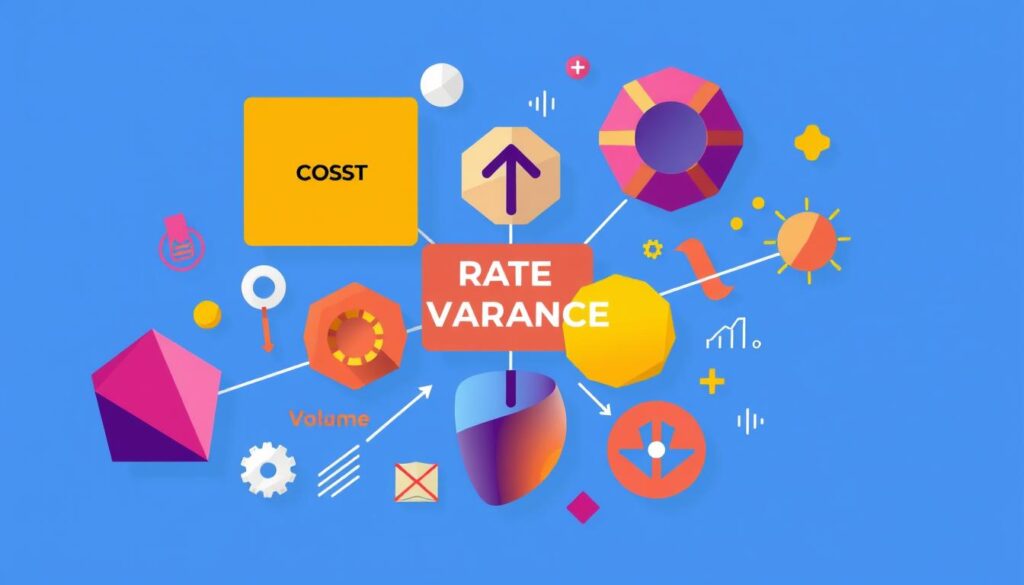Have you ever looked at your financial reports and felt confused? Noticed numbers that don’t match what you expected? This is often due to rate variance, a critical concept that affects your business’s financial health.
Understanding rate variance is key in the complex world of finance. It helps you see where your estimates might have gone wrong. By examining rate variance closely, you learn more about its causes and effects.
This knowledge makes planning and decision-making easier. It lets you adjust to market changes and meet operational demands better. So, embracing rate variance analysis is a smart move. It improves your forecasting skills and response to changes.
Key Takeaways
- Understanding rate variance is crucial for effective financial analysis.
- Components of rate variance include price, volume, and mix variances.
- COGS variances are analyzed against annual budgets to track performance.
- Identifying variances helps in recognizing potential financial discrepancies.
- Rate changes can significantly impact overall costs and budgeting decisions.
- Variance analysis is vital for navigating market instability and tracking performance.
What is Rate Variance?
Rate variance is key to understanding a company’s financial health. It shows the cost differences between expected and actual figures. This helps businesses see how well they are doing. It also spots areas needing improvement. With rate variance, companies can better plan their budgets and forecasts.
Defining Rate Variance in Financial Terms
Calculating rate variance is straightforward. Take financial variance, for example. You subtract the standard price from the actual price, then multiply by the actual quantity bought. In the case of labor, we look at the difference between expected and actual labor rates. This is crucial for analyzing labor costs.
- Rate Variance = (Actual Rate − Standard Rate) × Actual Hours Worked
- The standard labor rate considers factors such as employee pay levels and potential overtime.
- Labor rate variance can be either unfavorable or favorable, influencing financial strategies.
The Importance of Understanding Rate Variance
Rate variance is vital for fine-tuning financial strategies. By examining it, companies can tweak their budgets or predict future trends. An unfavorable variance means costs were higher than planned. A favorable one means savings. Keeping track of these variances helps companies make smart choices.
For instance, Hodgson Industrial Design encountered a labor rate variance with costs above estimates for a month. Analyzing such differences helps firms revise their pricing or evaluate their operational decisions. This includes looking at employee training and how resources are used.
Components of Rate Variance
Rate variance analysis includes three key parts: price variance, volume variance, and mix variance. Knowing these helps you make smart decisions and boost finances.
Price Variance
Price variance shows the difference between actual and budgeted unit costs. You find it by subtracting the standard cost from the actual cost, then multiply by units bought. A positive variance means costs were higher, while a negative one shows savings. Handling this variance is key to budgeting. It could mean buying in bulk to save money, despite risking too much stock.
Volume Variance
Volume variance compares actual to expected sales. It’s found by looking at the number of units sold versus the budget. Sales differences affect revenue and profit. This requires adjusting production and marketing to meet sales goals. Knowing volume variance helps adjust to market changes and use resources well.
Mix Variance
Mix variance arises when real product sales don’t match plans. It affects how much money and profit each product brings in. By studying mix variance, you can spot changes in what customers want and adjust products. Good mix management boosts profits and market position.

| Variance Type | Calculation | Implications |
|---|---|---|
| Price Variance | (Actual Cost – Standard Cost) x Actual Units Purchased | Indicates cost efficiency or inefficiencies in purchasing |
| Volume Variance | (Actual Sales – Budgeted Sales) x Standard Contribution Margin | Highlights deviation from sales expectations |
| Mix Variance | (Actual Sales Mix – Planned Sales Mix) x Total Units Sold | Shows changes in product demand and profitability |
Analyzing Rate Variance Effects
Understanding how analyzing rate variance affects a business is crucial. It helps companies measure their financial health. By looking into why variances happen, businesses can better plan budgets and improve strategies. This way, they know when they’re doing well or need to fix things, making smarter decisions for better operations.
How Rate Variance Influences Financial Performance
Analyzing rate variance helps compare what was planned against what actually happened. This shines a light on over or under-performance. Price and quantity variances in materials and labor can greatly impact financial results. So, it’s important for management to pay close attention to big variances, as they can point to big issues that need quick action.
Imagine finding a $3,000 materials variance and a $4,800 labor variance that weren’t expected. Or noticing a total $1,600 variance in overhead because of budget and volume differences. Such findings let a business pinpoint where costs are too high, allowing for needed changes.
Case Studies: Real-World Implications of Rate Variance
Real-life examples show why it’s important to analyze rate variance. When companies spot and respond to these differences, they can make big improvements. Say a company sees higher material costs causing unfavorable pricing. They might rethink how they buy supplies. On the flip side, small price variances can show good cost control, with actual spending lower than expected.
When things go better than expected, it’s a sign of strength. It might mean earning more than planned or spending less. This encourages companies to stick with what works and keep aiming for success. Using management by exception helps. It means only focusing on big wins or losses, so efforts go where they can really help the business grow.

Strategies for Managing Rate Variance
Managing rate variance well is key to keeping finances stable and improving performance. By using certain strategies, your organization can better handle differences and increase profits. These methods show how keeping a close eye on things and talking effectively can help manage rate variance.
Continuous Monitoring Techniques
Using continuous monitoring can really help control rate differences. Checking for variances regularly, especially during month-end closes, spots issues early. Being quick to notice how actual results compare to what was expected lets you fix things fast.
Here are some methods to try:
- Do monthly variance reports to see patterns.
- Use dashboards to look at data in real-time.
- Analyze variances deeply to find exact problems.
Importance of Integrative Communication
Integrative communication within your organization is vital. It makes sure everyone understands financial standings and needed changes. This clear sharing of information helps make better decisions, which helps manage rate variance.
Try these communication tips:
- Meet regularly between departments to talk about variances.
- Set up common places for sharing information.
- Teach your teams about financial differences and their effects.

Summary Table of Key Techniques
| Technique | Description | Benefits |
|---|---|---|
| Direct Monitoring | Regular variance analysis, using historical data. | Helps quickly identify discrepancies. |
| Performance Dashboards | Real-time data visualization platforms. | Immediate insights into performance metrics. |
| Inter-departmental Meetings | Regular discussions among teams. | Improves collaboration and understanding. |
| Training Programs | Educating teams about financial variances. | Enhances overall financial literacy. |
Adopting continuous monitoring and promoting good communication lets your organization handle rate variance better. This leads to better financial outcomes.
Conclusion
The conclusion on rate variance is key for financial stability and good budgeting. Understanding price, volume, and mix improves operational efficiency. It also boosts financial performance. This knowledge helps manage costs and improve production practices.
Effective use of variance analysis shows how your actual spending compares to your budget. It offers important financial insights. By regularly checking variances, you and your team can handle financial situations better. This helps avoid spending too much and keeps your finances strong.
Communicating well across departments and using past data helps grow profits. It makes it easier to find and fix money issues. Understanding cost variance is crucial for managing finances well.









